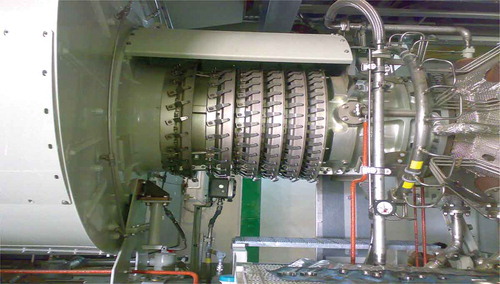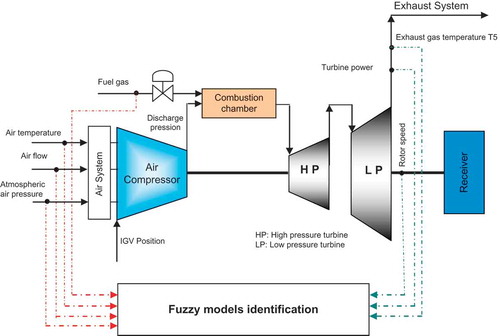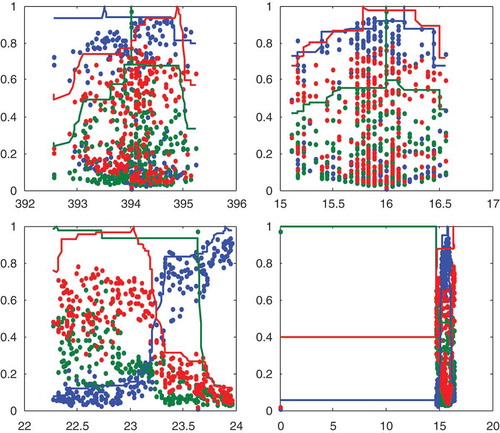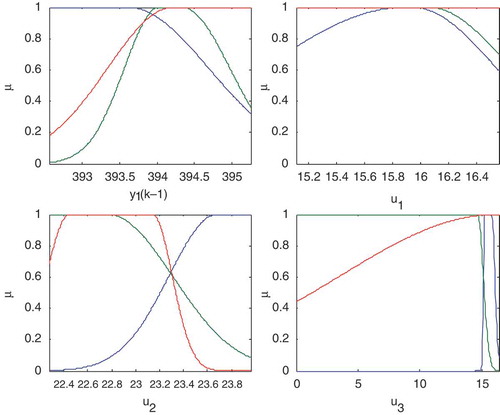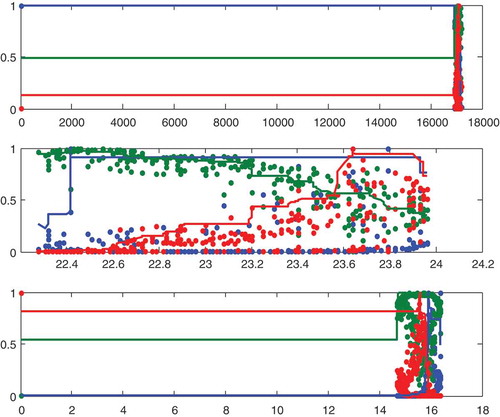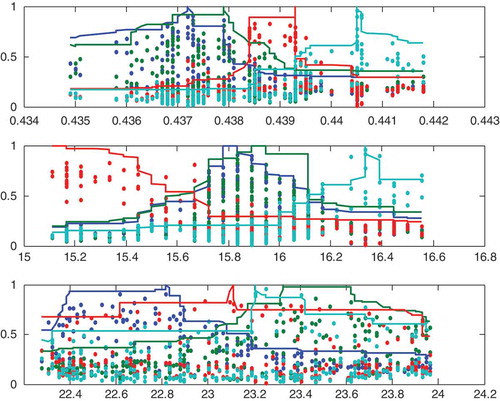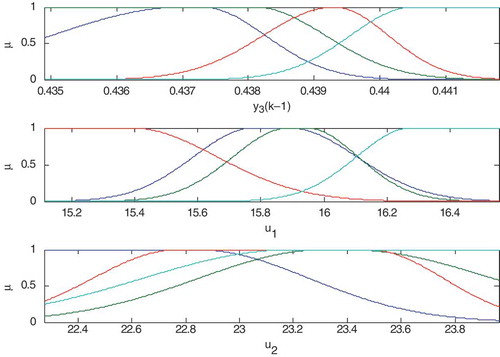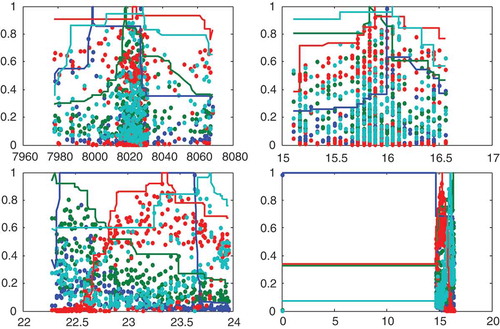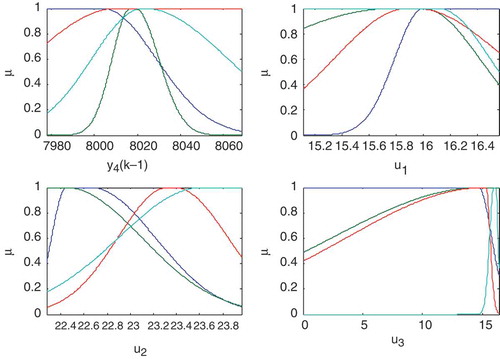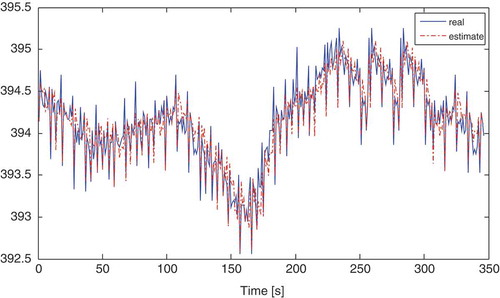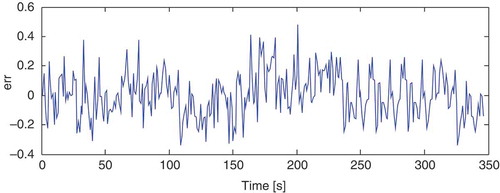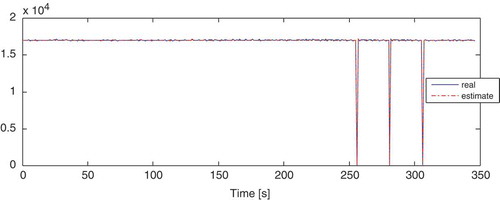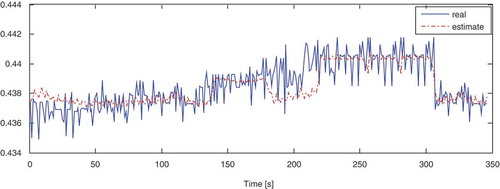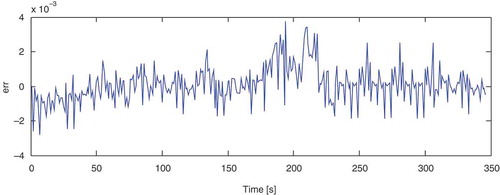ABSTRACT
The development of reliable mathematical models for nonlinear systems has been a primary topic in several industrial applications. This work proposes to examine the application of fuzzy logic to represent the control parameters of a gas turbine based on the fuzzy clustering method using Gustafson–Kessel algorithms. The results obtained from data classification of construction with associated models indicate applications in modeling the examined system.
Introduction
To reflect the overall characteristics of industrial systems and their operating conditions, prior models to supervise and control a system need to be established to maximize the performance in practice. The implementation of the governing equations in industrial systems usually leads to an excessively complex model of knowledge with control approaches that are delicate to implement (Feil, Abonyi, and Szeifert Citation2004; Kim, Ko, and Perez-Blanco Citation2011; Takagi and Sugeno Citation1985). In this case, the use of modeling techniques based on measured input/output collected for the system is required in order to reduce the complexity of modeling complex systems to improve the system performance (Dunn Citation1973; Gustafson and Kessel Citation1978; Bezdek and Douglas Harris Citation1979). This work proposes the use of fuzzy techniques for modeling the parameters of a gas turbine. The examined gas turbine is used to drive multistorey centrifugal compressors, and the data have been collected in real time in order to exploit the studied gas turbine. The quality of the universal fuzzy approximators, which has been approved in several works, transforms these nonlinear systems into a set of linear systems (Abonyi, Babuska, and Szeifert Citation2002; Ahmed et al. Citation2012; Robert 1998; Buckley Citation1992; Setnes, Babuška, and Verbruggen Citation1998; Vernieuwe, De Baets, and Verhoest Citation2004). Expert knowledge was not available in our case; the structure must be identified from the data. A fuzzy classification method can then be used to partition the data space into several classes. The use of a fuzzy clustering algorithm has an important advantage; it allows the automatic generation of fuzzy membership or data from regions’ functions. These models are constructed by minimizing a cost function.
Fuzzy identification methods have been developed from experimental data modeling in several works; the supervised and unsupervised learning methods are among the most-used fuzzy classification techniques (Babuška and Verbruggen Citation1995; Ruspini Citation1969; Barkó, Abonyi, and Hlavay Citation1999; Bezdek, Ehrlich, and Full Citation1984; Topalov et al. Citation2007; Abonyi et al. Citation2005). The works developed by Takagi and Sugeno (Citation1985) show that fuzzy techniques are effective tools for approximating nonlinear systems. Other techniques developed by Babuška et al. in (Abonyi, Babuška, and Szeifert Citation2002; Babuška and Verbruggen Citation1995; Robert Citation1998) have been used to construct these combined techniques as fuzzy least squares models. This work attempted to examine the application of fuzzy logic to represent the dice control parameters of a gas turbine based on the fuzzy clustering method using Gustafson–Kessel algorithms. The integration of these algorithms to provide real-time regulation will result in the recovery of the loss of gas production by ensuring optimal gas turbine operation. Several studies have focused on the problem of modeling this turbine and presented rigorous models with a complex mathematical structure, which significantly limited the possibility of their direct use via conventional control methods (Ablay Citation2013; Ahmed, Guemana, and Daoudi Citation2015; Jurado and Carpio Citation2006; Nikpey et al. Citation2014; Topalov Citation2011). These models were established at nominal operating conditions that hinder the control of the temperature and flow suction in this compression system.
To this end, this work proposes a fuzzy model that describes the dynamics of the gas turbine system. Using various tests, this study confirms that the obtained results clearly demonstrate the recurred main dynamic characteristics of the gas turbine system when using the proposed fuzzy model, enabling better performance during its operation for control synthesis.
Modeling based on fuzzy clustering
Today, specialized automatic control systems have become increasingly complex by considering not only the control problems but also low-supervisory-control problem layers, surveillance problems, diagnosis, and driving assistance. Therefore, the complexity of industrial systems is a dimension to which the different levels of modeling are added, which must have reliable mathematical models for implementation. Consequently, the nature of the information for handling industrial systems is significantly different compared with that for conventional control problems. Information for industrial systems is often derived from multiple sources, is qualitative in nature, and the data are usually imprecise and uncertain.
This article proposes the development of qualitative formalisms that elucidate various aspects of the methods and data processing, such as the methods based on fuzzy clustering. For these methods of clustering, the data are typically observations (measurements) from a certain physical process. Each kth observation is a vector with with
, where
is the number of observations and
is the number of measured variables. A set of observations
is given by
and represented as a data matrix given by the following:
Fuzzy clustering algorithms aim to partition a set of data by establishing a fuzzy partition of observations into a number of classes. This technique, which has proven very useful for the development of fuzzy classification, was introduced by Ruspini (Citation1969) for a fuzzy strict partition. For a fuzzy c-partition, a set Z can be achieved by defining c fuzzy subsets of Z such that the sum of the degrees of membership for each case Z is unity. A vector of degrees of belonging to different classes is associated with each observation vector, . This vector of degrees defines the membership matrix
, where the element
is the membership coefficient of observation
to class i. The membership matrix,
, is also called the fuzzy partition matrix and satisfies the following properties:
where the ith row of ,
, contains the degrees,
, of membership in the ith fuzzy set; the jth column of
,
, contains the
degrees of membership of the jth element of
of
subsets of fuzzy sets for the sum of all the degrees of membership of any given
data equal to 1; the sum of all elements of the same column is, therefore, equal to 1.
To use the fuzzy clustering algorithms in modeling, the number of class settings must be used as inputs for the algorithms; they share the set of objects into
groups. These algorithms iterate in two stages; first, they calculate the centers of groups, and they then assign each object to the nearest center. Each class is characterized by the center and its elements. A classification criterion is iteratively optimized to establish a fuzzy partition of a dataset into a number of classes. The data are grouped from a training phase using a similarity measure via classification techniques.
In this work, we used the two most common approaches used in the field of structure identification systems: standard FCM (Fuzzy C-mean) developed by Bezdek in (Bezdek and Dunn Citation1975; Tsao, Bezdek, and Pal Citation1994; Bezdek, Ehrlich, and Full Citation1984) and the algorithm proposed by Gustafson Kessel (GK) in (Gustafson and Kessel Citation1978). The first method allows the detection of hyperspherical classes, whereas the second detects hyperellipsoid classes and is typically better suited to the geometry of observations.
Fuzzy C-Means (FCM) algorithm
The fuzzy C-means (FCM) algorithms developed in the work of Dunn in (Bezdek and Dunn Citation1975; Dunn Citation1973) and later improved by Bezdek in (Bezdek and Dunn Citation1975; Tsao, Bezdek, and Pal Citation1994; Bezdek, Ehrlich, and Full Citation1984; Bezdek and Douglas Harris Citation1979) are a benchmark among different methods of fuzzy classification based on minimizing the following objective function:
where is the dataset,
is the matrix of fuzzy partitions (size
) and
is the vector of the center of classes to be determined with
; the center of the ith class,
,
, is a factor that denotes the degree of fuzziness of the partition.
The standard quadratic distance in the space in question, which defines the distance measure between the observation and the
center within the meaning of the metric induced by
, specified by Frigui and Krishnapuram (Citation1996) and Frigui et al. (Citation2007), this standard quadriatic distance is given by the following equation:
In Equation (4), the measurement of nonsimilarity is expressed by of the sum of squares of distances between each
data vector and the
center of the corresponding class. The effect of this distance is weighted by the degree of activation,
, corresponding to the
data vector; the value of the cost function
can be considered a measure of the total variance of
with respect to the
centers. The minimization of the objective function in Equation (4) is given as follows:
The principle of the algorithm is given in three steps:
Step 1:
Calculate the cluster centers:
Step 2:
Calculate the distances:
Step 3:
Update the partition matrix: if for
, then
Otherwise, if
and
with
to
.
The form class is determined by the choice of matrix in the equation; the particular choice
induces the standard Euclidean norm given in Equation (8); in this case, the detected classes have spherical shapes:
In the next section in this work, the FCM algorithm will be applied to the classification of the examined data for the gas turbine in order to find the clusters in this system.
Gustafson–Kessel algorithm (GK)
Gustafson and Kessel (Citation1978) generalized the FCM algorithm using a standard adaptive distance to detect different classes of geometric shapes in a dataset. In this case, each class has its own standard matrix, which results in the following:
where is set for each class, and the matrix
tests the hypothesis
. In this case, the optimization of Equation (4) yields the following expression for
:
where is the fuzzy covariance matrix of the ith class given by the following:
This equation leads to the Gustafson–Kessel algorithm, GK, which is given in four steps:
Step 1:
Calculate the cluster centers:
Step 2:
Calculate the covariance matrices of the classes:
Step 3:
Calculate the distances:
Step 4:
Update the partition matrix:
If for
, then
Otherwise, if
and
with
to
.
The advantage of theGK algorithm over the FCM algorithm is its ability to detect classes of different shapes and orientations in a single dataset.
Industrial application
Examined gas turbine
The gas turbine subject of this work was designed with four levels using plain, skid, oscillating, elliptical, and lubricated bearings under pressure. The blades of the turbine wheel and the rotor blades also interacted closely to maximize the yields of the component elements and increase production. The gas turbine plant shown in improves the performance and allows the load to vary between the HP and LP turbine.
Gas turbines are widely used in the oil industry, the production of electrical energy, and other industrial sectors. The supervision of these gas turbine systems is important in order to extend their lives, increase the uptime, and ensure the proper operation of the gas compression station (Ahmed, Guemana, and Daoudi Citation2015; Hafaifa, Laaouad, and Laroussi Citation2011; Hafaifa, Laroussi, and Laaouad Citation2010; Wu, Huang, and Zhu Citation2011). The variables of the examined gas turbine handled in this work are the mass flow rate of the fuel, , given by the following:
The air mass flow is given by the following:
We must control the combustion fuel report, , which is defined as follows:
The gas turbine airflow is given as follows:
The energy increase per stage can be written as follows:
where is the total enthalpy in the inlet and exit of the gas turbine, and
is the number of stages.
The transported gas in the pipeline is considered perfect (the compression and expansion are isentropic), and and
are constant; thus, Equation (16) can be rewritten as follows (Ford, Carrotte, and Walker Citation2013; Guasch, Quevedo, and Milne Citation2000; Ahmed, Daoudi, and Laroussi Citation2011):
where is the total inlet temperature, and
is the total pressure of the inlet and exit of the gas turbine.
Assume that the air around the cycle can then introduce the compression ratio to Equation (17):
The compressor discharge temperature is given by , where
,
is the compressor discharge temperature,
is the compressor inlet temperature (atmosphere temperature),
is the air flow, and
is the compressor efficiency (Jagaduri and Radman Citation2007; Wahba and Nawar Citation2013).
The data handled for the gas turbine examined in this work are the fuel gas, the air temperature, the air flow, the atmospheric air pressure, the exhaust gas temperature, the turbine power, and the rotor speed. These measures will be used to provide different input–output fairs for closed loop control in the examined gas turbine shown in .
Fuzzy model identification
The examined system given by inputs and
outputs is described by the following after decomposing each subsystem:
The regression vector is given by the following:
where ,
is the discrete time, the sample is an integer in the system order, and
and
are the number of delayed inputs and outputs.
The system is independently identified to simplify the notation; the index will be ignored, and the output of the system is written as follows:
where is a constant.
The unknown function is approximated using a fuzzy Takagi–Sugeno (TS) model (Berchtold et al. Citation2008; Tsao, Bezdek, and Pal Citation1994) by applying the GK algorithm. The data space is divided into a plurality of focus areas, as described in our case by Gaussian membership functions, whereas the consequent sections describe the operation of the system in these areas. The rule base in the examined system takes on the following form:
is the antecedent fuzzy set of the ith rule,
and
are the vectors of two polynomials and
, and
is the number of rules.
Rule (22) can then be written as follows:
IF
est
and …and
est
. Next,
where
The output of the TS model is then evaluated using the following:
by taking
where is the validation feature of the Gaussian function with parameters
as the centers and variances
.
Formula (24) takes the following form:
The dataset is constructed by concatenating the regression matrix
and vector regressing
:
where is the number of observations.
By applying the fuzzy classification, the dataset in the examined gas turbine is partitioned into
fuzzy subsets. The membership values of the data groups will be described by a matrix of fuzzy partitions,
with
. The membership degree of the observation
of the group
is shown in and . Each group is characterized by a
center,
are the vector center and a covariance matrix,
, describes the variance of data in the group
. The selected Gaussian membership functions are given by the following:
The substantial parameters, , are each estimated using the square recursive algorithm while minimizing the following objective function:
where is the matrix of regression increased by adding a unit column vector, and
is a matrix containing the values of the linear function validities
for the local ith model of each data group.
The least squares substantial parameters estimation is given by the following:
In this examined case, the online adaptation of a fuzzy model is necessary in order to obtain a model capable of continuing the system in its evolution; this approach results in a TS model described by the following:
During this adaptation phase, shows the partition and projection of output y2, the parameters of the background are stationary, only the substantial parameters are adapted. For each ith local linear model, the new estimated parameters are given by the following:
The TS fuzzy model validation can be obtained using the variance accounting for (VAF) to calculate the standard deviation as a percentage of the variance between the measured output and the estimated output; the used validation test is defined as follows:
Application results
In this work, we considered the basic parameters in gas turbine control, four input and four output variables, without taking into account other variables of the examined gas turbine. In this case, the obtained results for these variables are shown in , and for the output membership function and for its fuzzy partition and projection is shown in and . Thus, the examined system order is 4 x 4.
with
The vectors of the regression for each subsystem are
To approximate the unknown function with a fuzzy TS model, the proposed GK algorithm was used to divide the data space into a plurality of focus areas. This algorithm was initialized by a number of classes,
; the centers of matrices and covariance matrices are calculated (Index A), and the substantial parameters,
, are estimated using Equation (37). The rule base for each subsystem takes the following form:
The major advantage of the proposed approach based on fuzzy logic modeling lies in its ability to translate a control strategy described in a dataset easily interpretable to the operator. shows the variations of the measured exhaust gas temperature using the proposed fuzzy model identification, and shows the associated error. Furthermore, shows the variations of the isentropic shaft power in the examined gas turbine, and shows the associated error.
Other important parameters used in the control of the examined gas turbine were tested to validate the effectiveness of the proposed strategy in this work. The variations of the isentropic efficiency and its associated error and the variations of the compressor speed with its associated error are shown in , , and , and , respectively.
Conclusions
This work has addressed one of the major problems in the search for reliable mathematical representation; the proposed fuzzy model provides a good improvement in the performance during its operation for the synthesis of the controller in the examined gas turbine. The use of a fuzzy clustering algorithm has the important advantage of allowing the automatic generation of membership functions of fuzzy regions from studied data. This work confirms that the development of a digital approach is more flexible to implement based on the proposed method of fuzzy clustering algorithms using the Gustafson–Kessel approach. The results obtained from data classification with the construction of the associated models offer advantageous performance in modeling the examined gas turbine system. This approach can provide reliable models for controlling the gas turbine, which increases the exploitation coefficient for gas compression stations to increase gas production.
References
- Ablay, G. 2013. A modeling and control approach to advanced nuclear power plants with gas turbines. Energy Conversion and Management 76 (December):899–909. doi:10.1016/j.enconman.2013.08.048.
- Abonyi, J., R. Babuska, and F. Szeifert. 2002. Modified Gath-Geva fuzzy clustering for identification of Takagi-Sugeno fuzzy models. IEEE Transactions on Systems, Man and Cybernetics, Part B (Cybernetics) 32 (5):612–621. doi:10.1109/TSMCB.2002.1033180.
- Abonyi, J., B. Feil, S. Nemeth, and P. Arva. 2005. Modified Gath–Geva clustering for fuzzy segmentation of multivariate time-series. Fuzzy Sets and Systems 149 (1):39–56. doi:10.1016/j.fss.2004.07.008.
- Ahmed, H., A. Daoudi, and K. Laroussi. 2011. Application of fuzzy fault detection and isolation approach to the compression system surge. ACTA Press, Control and Intelligent Systems 39 (3):151–158.
- Ahmed, H., M. Guemana, and A. Daoudi. 2015. Vibration supervision in gas turbine based on parity space approach to increasing efficiency. Journal of Vibration and Control 21 (8):1622–1632. doi:10.1177/1077546313499927.
- Ahmed, S., N. Shakev, A. V. Topalov, K. Shiev, and O. Kaynak. 2012. Sliding mode incremental learning algorithm for interval Type-2 Takagi-Sugeno-Kang Fuzzy Neural networks. Evolving Systems 3:179–188. doi: 10.1007/s12530-012-9053-6.
- Babuška, R., and H. B. Verbruggen. 1995. Identification of composite linear models via fuzzy clustering. Paper presented at Proceedings of the European Control Conference, Rome, Italy, September 5–8.
- Barkó, G., J. Abonyi, and J. Hlavay. 1999. Application of fuzzy clustering and piezoelectric chemical sensor array for investigation on organic compounds. Analytica Chimica Acta 398 (2–3):219–226. doi:10.1016/S0003-2670(99)00377-3.
- Berchtold, M., T. Riedel, C. Decker, and K. Van Laerhoven. 2008. Gath-Geva specification and genetic generalization of Takagi-Sugeno-Kang fuzzy models. In IEEE international conference on systems, man and cybernetics, SMC 2008. 595–600. IEEE.
- Bezdek, J. C., and J. Douglas Harris. 1979. Convex decompositions of fuzzy partitions. Journal of Mathematical Analysis and Applications 67 (2):490–512. doi:10.1016/0022-247X(79)90039-8.
- Bezdek, J. C., and J. C. Dunn. 1975. Optimal fuzzy partitions: A heuristic for estimating the parameters in a mixture of normal distributions. IEEE Transactions on Computers C-24 (8):835–838. doi:10.1109/T-C.1975.224317.
- Bezdek, J. C., R. Ehrlich, and W. Full. 1984. FCM: The fuzzy c-means clustering algorithm. Computers & Geosciences 10 (2–3):191–203. doi:10.1016/0098-3004(84)90020-7.
- Buckley, J. J. 1992. Universal fuzzy controllers. Automatica 28 (6):1245–1248. doi:10.1016/0005-1098(92)90068-Q.
- Dunn, J. C. 1973. A fuzzy relative of the ISODATA process and its use in detecting compact well-separated clusters. Journal of Cybernetics and Systems 3 (3):32–57. doi:10.1080/01969727308546046.
- Feil, B., J. Abonyi, and F. Szeifert. 2004. Model order selection of nonlinear input–output models––a clustering based approach. Journal of Process Control 14 (6):593–602. doi:10.1016/j.jprocont.2004.01.005.
- Ford, C. L., J. F. Carrotte, and A. D. Walker. 2013. The application of porous media to simulate the upstream effects of gas turbine injector swirl vanes. Computers & Fluids 77 (April):143–151. doi:10.1016/j.compfluid.2013.03.001.
- Frigui, H., and R. Krishnapuram. 1996. A robust clustering algorithm based on competitive agglomeration and soft rejection of outliers. In Proceedings of IEEE computer society conference on computer vision and pattern recognition, 550–555. IEEE.
- Frigui, H., C. Hwang, and F. C.-H. Rhee. 2007. Clustering and aggregation of relational data with applications to image database categorization. Pattern Recognition 40 (11):3053–3068. doi:10.1016/j.patcog.2007.02.019.
- Guasch, A., J. Quevedo, and R. Milne. 2000. Fault diagnosis for gas turbines based on the control system. Engineering Applications of Artificial Intelligence 13 (4) 1:477–484. doi:10.1016/S0952-1976(00)00014-2.
- Gustafson, D. E., and W. C. Kessel. 1978. Fuzzy clustering with a fuzzy covariance matrix. In Proceedings of IEEE conference on decision and control including the 17th symposium on adaptive processes, 17, Part: 1, 761–766. IEEE.
- Hafaifa, A., F. Laaouad, and K. Laroussi. 2011. A numerical structural approach to surge detection and isolation in compression systems using fuzzy logic controller. International Journal of Control, Automation, and Systems, (IJCAS) 9 (1):69–79. doi:10.1007/s12555-011-0109-3.
- Hafaifa, A., K. Laroussi, and F. Laaouad. 2010. Robust fuzzy fault detection and isolation approach applied to the surge in centrifugal compressor modeling and control. Fuzzy Information and Engineering 2 (1):49–73. doi:10.1007/s12543-010-0037-6.
- Jagaduri, R. T., and G. Radman. 2007. Modeling and control of distributed generation systems including PEM fuel cell and gas turbine. Electric Power Systems Research 77 (1):83–92. doi:10.1016/j.epsr.2006.02.003.
- Jurado, F., and J. Carpio. 2006. Improving distribution system stability by predictive control of gas turbines. Energy Conversion and Management 47 (18–19):2961–2973. doi:10.1016/j.enconman.2006.03.028.
- Kim, K. H., H.-J. Ko, and H. Perez-Blanco. 2011. Analytical modeling of wet compression of gas turbine systems. Applied Thermal Engineering 31 (5):834–840. doi:10.1016/j.applthermaleng.2010.11.002.
- Nikpey, H., M. Assadi, P. Breuhaus, and P. T. Mørkved. 2014. Experimental evaluation and ANN modeling of a recuperative micro gas turbine burning mixtures of natural gas and biogas. Applied Energy 117 (March):30–41. doi:10.1016/j.apenergy.2013.11.074.
- Babuška, R.. 1998. Fuzzy modeling for control. International Series in Intelligent Technologies, 12. The Netherlands: Springer Netherlands. ISBN: 0792381548, 9780792381549.
- Ruspini, E. H. 1969. A new approach to clustering. Information and Control 15 (1):22–32. doi:10.1016/S0019-9958(69)90591-9.
- Setnes, M., R. Babuška, and H. B. Verbruggen. 1998. Complexity reduction in fuzzy modeling. Mathematics and Computers in Simulation 46 (5–6):507–516. doi:10.1016/S0378-4754(98)00079-2.
- Takagi, T., and M. Sugeno. 1985. Fuzzy identification of systems and its applications to modeling and control. IEEE Transactions on Systems Man and Cybernetics SMC-15 (1):116–132. doi:10.1109/TSMC.1985.6313399.
- Topalov, A. V. 2011. A new stable on-line learning algorithm for Takagi-Sugeno-Kang type neuro-fuzzy networks. Comptes Rendus De L Academie Bulgare Des Sciennces, (Sciences Et Ingenierie, Automatique Et Informatique), Tome 64 (10):1489–1498.
- Topalov, A. V., G. L. Cascella, V. Giordano, F. Cupertino, and O. Kaynak. 2007. Sliding mode neuro-adaptive control of electric drives. IEEE Transactions on Industrial Electronics 54 (1):671–679. doi:10.1109/TIE.2006.888930.
- Tsao, E. C.-K., J. C. Bezdek, and N. R. Pal. 1994. Fuzzy Kohonen clustering networks. Pattern Recognition 27 (5):757–764. doi:10.1016/0031-3203(94)90052-3.
- Vernieuwe, H., B. De Baets, and N. E. C. Verhoest. 2004. Clustering-based identification of TS-models: Comparison on a groundwater model case study. In Proceedings of the IEEE international conference on fuzzy systems, 2004, 3, 1685–1690. IEEE.
- Wahba, E. M., and H. Nawar. 2013. Multiphase flow modeling and optimization for online wash systems of gas turbines. Applied Mathematical Modelling 37 (14–15):7549–7560. doi:10.1016/j.apm.2013.01.056.
- Wu, X.-J., Q. Huang, and X.-J. Zhu. 2011. Thermal modeling of a solid oxide fuel cell and micro gas turbine hybrid power system based on modified LS-SVM. International Journal of Hydrogen Energy 36 (1):885–92. doi:10.1016/j.ijhydene.2010.08.022.

